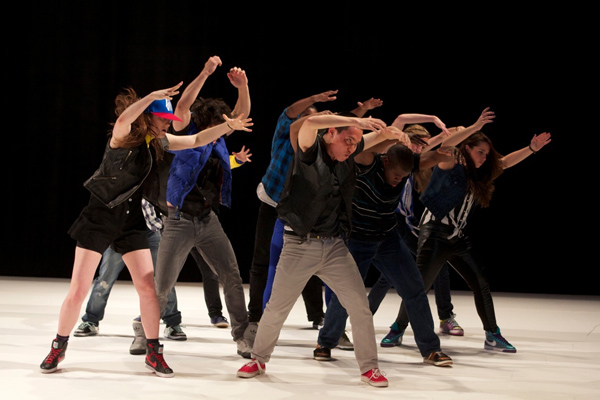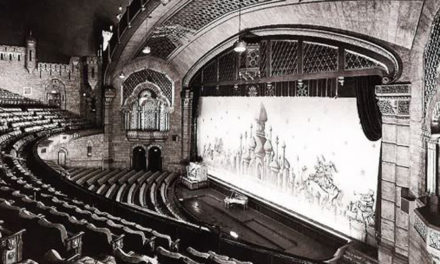“Blank slate” is a phrase that gets thrown around a lot. But never has that phrase been more appropriate or foreboding than as the title of the student choreography production that will grace the stage of the Schwartz Center for Performing Arts this weekend.
The Emory Dance Company’s (EDC) Spring Concert is an annual opportunity for students in the dance department to present their own choreography in a professional environment. This year, the performance, which will run April 25-27, features world premieres by College seniors Kayla Davis, Lauren Kaplan, Heidi Liu, Andre Lumpkin and Julio Medina and College junior Emily Hammond.
Davis explained that the performance title of “Tabula Rasa” describes a blank slate between each piece. “All of our pieces – all of us – are so different,” she said. “We liked the idea of the audience being able to clean the slate between each of our pieces.”
Indeed, as I discovered when I sat in on final rehearsals this week, each piece has its own tone, conveys its own ideas and elicits its own feelings.
Medina’s “Escucha la Ciudad,” or “Listen to the City,” is a piece of layers. At its most basic, it’s hip-hop. But it’s also about the mixture of dance genres – bringing hip-hop to the concert dance stage – and of people themselves.
“We’ve got a German girl, a Latina, East Asians, a girl from the Midwest, the southern boy,” Medina said, scanning over his dancers. “Bringing all these very different people together … it’s been really cool.”
The diversity is obvious in their appearances but also in their dance styles. Within the group, there are native hip-hoppers, modern dancers, ballet dancers. Yet for this piece, they don’t seem all that different: they perform with the same power, ferocity and unabashed cool.
On the exact other end of the spectrum is Kaplan’s “How Much Space Between Each Clap,” a traditionally modern piece which seemingly only utilizes the entire group as something from which to break away.
“It didn’t stray [from what I thought I was working toward], but it definitely becomes its own entity,” Kaplan explained.
That’s unexpected, because the piece comes across as extremely precise, with every movement appearing calculated and determined. It explores several dichotomies: tension and release, unity and individuality, fluidity and permanence.
The piece is most intriguing in the hands of Hammond and Medina, two of the piece’s seven dancers, when they attempt to execute a duet. At least, Hammond does: she reaches for Medina, only to be pushed away. Yet she still continues dancing behind him, as if struggling to keep up. The two of them are graceful yet strained, delicate yet unsatisfied.
That sense of complexity carries over into Hammond’s own contribution to the production, “I Have the Nicest Surprise For You.” She was inspired by Oscar Wilde, who once wisely noted, “Life is far too important a thing ever to talk seriously about it.”
And that’s really the only way to absorb the work. Hammond said she was inspired by audiences’ innate desire to “understand” dance, and she hopes to encourage people “to not take the art form quite so seriously.”
“I Have the Nicest Surprise For You” is primarily composed of duets: variations of similar phrases, simplistic motions transformed into theatre. The piece is constantly changing, taking different turns. It’s confusing and disjointed, but that’s exactly what Hammond was going for.
Next up is “Ordeal of Ideals,” Lumpkin’s contribution to “Tabula Rasa.” The thing that first strikes your eye is the onstage mirrors – but that’s far from all Lumpkin has to offer.
“Ordeal of Ideals” is visceral, emotive and intuitive. The dancers support one another – some equally, some unequally – and help move the mirrors, giving them all a chance to examine their reflections.
At one point, a voice in the music articulates, “We have this idea that for connection we have to let ourselves be seen.”
And there are many variants of being seen in this piece. In one particularly striking moment, the group gathers around four dancers, giving the impression of them being in a fishbowl. And at the end, the dancers bring the mirrors forward, forcing the audience to notice their own reflection.
On another note is Liu’s “Seas of Different Densities,” a scientific look at human relationships.
“There’s this place off the Alaskan coast where two seas meet,” Liu explained. “But they can never join, because they’re of different densities … and that’s kind of beautiful but also tragic.”
The piece applies that maritime phenomenon to basic human interaction, as the work focuses on the group as a whole, duets, trios and every other arrangement imaginable. Each duet has a different feel to it: some are more serene, some are tenser – but ultimately, they all face the same struggle to fully unite.
“There’s an intimacy that’s not necessarily physical,” Liu continued.
Indeed, the most intimate moments onstage occur in the midst of the group sections not in the showcased duets.
It’s a reversal of expectations that Liu takes to heart, exploring “separation that can never be fully reconciled.”
Last but certainly not least is “Impermanence,” Davis’ offering to “Tabula Rasa.” In this case, the title speaks for itself.
“Eventually, everything we have goes,” Davis explains. “[It’s about] this insane obsession people have with holding onto things that inevitably won’t last.”
That vision is clear both literally and figuratively in the piece. The six dancers repeatedly divide into groups, and while one group dances, the other sustains one constant position. They may be holding onto that one moment, but someone is always moving.
The choreography clearly requires power, but it’s elegant. The dancers are continually transferring weight from their feet to their hands to their sides, but they maintain a sense of calm. They struggle to balance, fall and catch one another. As Davis said, “they’re trying to navigate things together.”
From the instability of humanity to the universalization of hip-hop, from incapacity to unite to accepting a lack of understanding, there really isn’t one easy way to sum up the stories behind Emory Dance Company’s Spring Concert.
But as Davis pointed out, that’s not really the point of EDC. She noted, “I hope people come into our show … not looking for a story, but to have an experience.”
– By Emelia Fredlick
Photo by Lori Teague
The Emory Wheel was founded in 1919 and is currently the only independent, student-run newspaper of Emory University. The Wheel publishes weekly on Wednesdays during the academic year, except during University holidays and scheduled publication intermissions.
The Wheel is financially and editorially independent from the University. All of its content is generated by the Wheel’s more than 100 student staff members and contributing writers, and its printing costs are covered by profits from self-generated advertising sales.






Hi, i have reading out and i will definitely bookmarrk your site, just wanted to say i liked this article.
Very good deal, fast delivery!
Fast and friendly!